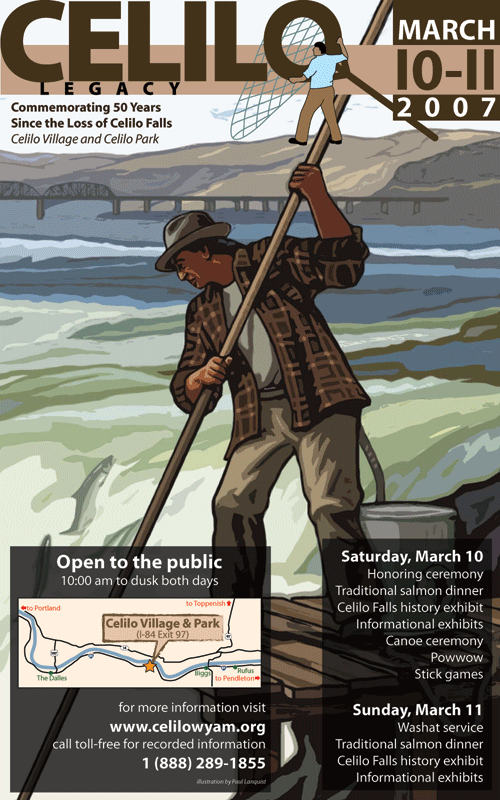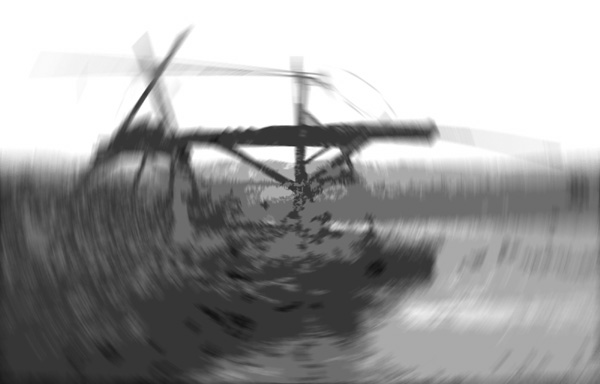Celilo Legacy - March 10-11, 2007
Commemorating 50 Years Since the Loss of Celilo Falls

Celilo Legacy volunteer and event information at www.critfc.org/legacy.
Wy-Am - Sound of Water upon the Rocks
Recalling Celilo Saturday, July 23, 2005 8:00am Blessing Ceremony (Wa'shut) Sunday, July 17, 2005 CELILO VILLAGE -- It's been a long time coming, even by government agency standards. But as workers finished a new longhouse this summer at Celilo Village east of The Dalles, the tribes that use the village as a fishing, religious and cultural center expressed cautious optimism that promises made will become promises kept.
Celilo Falls, Columbia River
Flooded March 10th, 1957

Tribal salmon harvest
Opening & Blessing of Celilo Wy-Am Longhouse
Leaders:
Lonnie Selam
Jerry Meninick
Dallas Winishut
Armand Minthorn
Bronsco Jim Jr.
9:00am Opening of longhouse (give-away)
9:30am Presentations & Remarks
- LT General Carl Strock-Chief, Corp.of Engineers
- Confederated Tribes of the Warm Springs Reservation
- Yakama Indian Nation
- Confederated Tribes of the Umatilla Indian Reservation
- Nez Perce Nation
- Celilo Wy-Am
12:00pm Traditional lunch
Open floor
Celilo's cultural centerpiece
ERIC MORTENSON
The Oregonian
"We were skeptical all these years, but we're seeing the longhouse rebuilt, and that feels real," said Delilah Heemsah, 33, who has spent her life in the dilapidated village. "We'll probably believe it when the whole village is renewed."
The longhouse work was an extension of a $67 million project undertaken by the U.S. Army Corps of Engineers and four tribes to restore, replace or re-establish 31 traditional salmon fishing sites along the Columbia River.
At the request of the tribes, the corps added improvements to Celilo Village to the project. The work includes rebuilding the longhouse, which is used for religious services and community celebrations. The corps also will replace the collection of run-down houses scattered about the settlement, fix the road into the village, and improve the sewage collection system and treatment lagoon. A new well has been dug.
Still, the doubts are understandable, given history's lessons. The work has its roots in an 1855 treaty between the federal government and the Warm Springs, Yakama, Umatilla and Nez Perce tribes.
The treaty, ratified in 1859 -- the year Oregon became a state -- guaranteed the tribes the right to fish at usual and accustomed sites along the Columbia River. But about 40 fishing sites in the lower Columbia were flooded by construction of the Bonneville, The Dalles and John Day hydroelectric dams.
Celilo Falls, once a thundering rapids where Native Americans standing on precarious platforms netted migrating salmon, was among the sites that disappeared as the system of dams turned the Columbia into a series of slow-moving pools.
The original Celilo Village at the falls was a year-round home to many Native Americans, and served as a gathering point and trade site for tribes that harvested the spring and fall salmon runs. Construction of The Dalles dam in 1957 flooded the falls and forced the relocation of resident families.
Over time, the village became an eyesore, cut off from reservation services that benefited other Native Americans. A recent review by the corps determined that about 50 people were living in the village year-round, and that all of them lived at or below the poverty level. The corps originally provided 14 homes, but some had become uninhabitable and were replaced or modified over the years with modular units or trailers. The influx of people during fishing seasons strained the water and sewage systems.
The corps handled the original relocation poorly, said George Miller, manager of the current corps project.
"The people were moved as an afterthought: 'How do we move these people out of way so we can build the dam?' " he said.
Addressing a problem "The facilities provided were Army surplus housing that in some cases didn't even meet the standards of the day," Miller said. "We prepared a report that evaluated Celilo Village. The long and short of the review is that the corps was involved in the relocations, they clearly don't meet any reasonable standard, and we have a problem out there that needs to be addressed."
The work is long overdue, Miller said.
Heemsah said she and others appreciate the improvements but couldn't help wondering if they were intended to make the village look good in time for the bicentennial celebration of the Lewis & Clark Expedition, which is drawing visitors to follow the explorers' path through the Columbia Basin and Indian country.
Heemsah is one of two village representatives on a Wy'am advisory board working with the corps on the Celilo project. The other members are two representatives each from the Yakama, Warm Springs and Umatilla nations. Although the Nez Perce farther upriver were involved in the original treaty, they aren't party to the village reconstruction work.
The heart of the village Although the village infrastructure work is important, the heart of the project involves rebuilding the longhouse. The Confederated Tribes of the Warm Springs donated the poles and decking for the A-frame longhouse. Connected to the longhouse is a large commercial kitchen, bathrooms and a dining room with a wood stove.
The longhouse essentially is a church and community center, Heemsah said. Services of the Washat religion are held on Sunday mornings, with drumming and songs. Men traditionally gather on the north side of the longhouse for the ceremony, women on the south side.
Longhouses also are used for funerals, namings, and to celebrate boys' first kill of deer or salmon and girls' first gathering of roots or berries, Heemsah said.
"Our religion is not written," she said. "Everything is kept in the heart and mind."
Keeping hope alive in the village has been more difficult.
"We survived on our own," Heemsah said. "We deal with the racists here. It still happens: We still get yelled at, cussed at, war-whooped at."
Which is why the longhouse project has come to symbolize so much. A dedication ceremony will be held Saturday.
"We're believing as we go along; we've got to watch every step, though," Heemsah said.
She allows herself some optimism.
"It just looks beautiful," she said. "I'm proud my generation can see it and very, very happy for my children."
Eric Mortenson; 503-294-5972; ericmortenson*news.oregonian.com
© 2005 The Oregonian